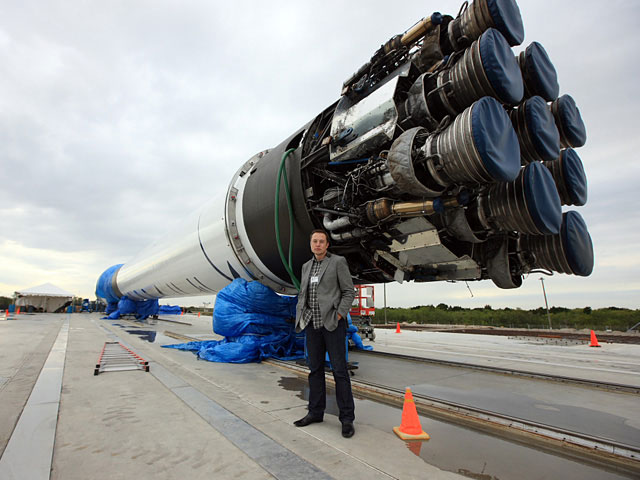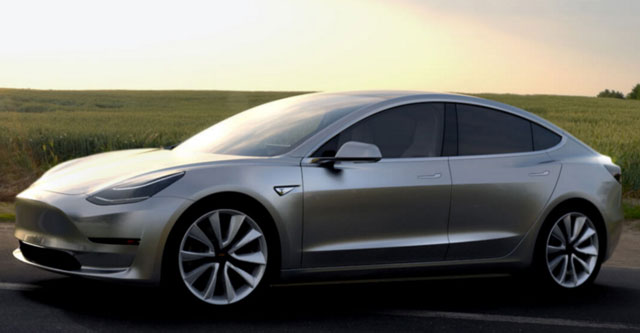
Elon Musk unveiled his latest “master plan” for Tesla Motors, delivering a long-term vision that includes an integrated solar and battery product, the addition of a pickup, freight truck and bus to its electric vehicle lineup, and plans for a ride-sharing business.
Musk published his long-awaited plan on Tesla’s website partly to explain why the company’s proposed integration with SolarCity will benefit consumers, who could effectively become their own utility. SolarCity, a rooftop solar panel installer, will generate electricity in tandem with Tesla’s Powerwall battery for the home. Tesla, meanwhile, will look beyond passenger vehicles to public transit and cargo shipping.
“In addition to consumer vehicles, there are two other types of electric vehicle needed: heavy-duty trucks and high passenger-density urban transport,” Musk, Tesla’s CEO, wrote in the blog post on Wednesday. “Both are in the early stages of development at Tesla and should be ready for unveiling next year. We believe the Tesla Semi will deliver a substantial reduction in the cost of cargo transport, while increasing safety and making it really fun to operate.”
Musk, 45, outlined “part deux” of his view of Tesla’s future even as much of the master plan he set for the company nearly a decade ago remains a work in progress. As laid out in Musk’s “Secret Tesla Motors Master Plan” in August 2006, Tesla has introduced more affordable electric cars and provided zero-emission electric-power generation options. Still, Tesla has reported a single quarterly profit along the way, and buyers who paid US$1 000 to pre-order the $35 000 Model 3 have been told deliveries will begin in late 2017.
Analysts are sceptical about Tesla’s ability to add even more products to its line-up given its history of product delays and cash burn. Tesla has bid $2,9bn to buy SolarCity even as the electric car maker has more long-term debt — $2,5bn — than its $1,4bn in cash and equivalents.
“As is typical, Elon Musk has laid out a grandiose plan for the future with no time frames and few specifics, and no mention of how and when Tesla will be profitable,” Michelle Krebs, an analyst for Autotrader.com, said in an e-mail. “Tesla’s latest master plan includes expanding its electric vehicle product line to cover all major segments, when it hasn’t been meeting production targets with the limited product line it has now and in the next couple of years.”
Tesla shares rose by 0,4% to $229,30 at 6.45am in New York in trading before US exchanges opened.
Delivery targets
Tesla aims to make 500 000 cars by 2018, though it delivered just 50 658 vehicles in 2015. The company missed its second quarter deliveries projection by about 2 600 vehicles and said earlier this month that full-year results may be slightly below its previous forecast for 80 000 to 90 000.
Besides the Tesla Semi truck and the bus, Musk said the company will continue to pursue self-driving technology so that customers will be able to use their cars to generate income while at work or on vacation. A car cheaper than the Model 3 is unlikely to be necessary because Tesla will ultimately operate its own fleet of vehicles, he said.
In integrating SolarCity, Tesla would be able to offer a single ordering experience, installation, service contract and phone app, Musk wrote. Tesla shares plunged more than 10% when the SolarCity acquisition proposal was first announced 21 June, but have since recovered. Analysts criticised the deal, pointing to Musk’s role as chairman and largest shareholder of both companies.
“We continue to see a divided investor base, with one camp bought in on the company’s vision and another focused on cash needs to fulfil that vision,” said Colin Rusch, a New York-based analyst at Oppenheimer & Co, who rates Tesla shares the equivalent of hold.

Tesla’s plans for the semi and pickup trucks, autonomous vehicles and solar and energy storage systems “will not surprise many investors”, Rusch wrote in a report Wednesday.
Musk wrote that Tesla will continue to press on with partially autonomous driving technology. A customer using Tesla’s Autopilot system in Florida was killed in a crash in May, prompting an investigation by the national highway traffic & safety administration that’s ongoing.
The Securities and Exchange Commission may also investigate the company for not disclosing the crash before its secondary stock offering in May, The Wall Street Journal said this month. Musk also recently lost a top executive in Rich Heley, formerly Tesla’s vice president of product technology, to Facebook.
‘Shocking piece’
Musk’s call to expand Tesla’s business beyond passenger cars amid all of these challenges is the latest brash proposal from an executive known for his unconventional approach to both the automotive and energy businesses. The semi-truck business is being led by Jerome Guillen, a former Daimler executive who recently returned to Tesla after a leave of absence, Musk said late Wednesday on Twitter.
“A bus and a semi-truck: that was a shocking piece to see,” Dave Sullivan, an analyst at AutoPacific, said by phone. “Those segments have traditionally been very difficult segments for electric vehicles. It’s a challenge for any company, not just Tesla. And it’s a significant step away from making passenger vehicles.”
Musk first tweeted that he was working on a master plan on 10 July. Since then, he has tantalised his more than 4m Twitter followers with titbits about his progress and distractions, even joking about smoking crack.
“Starting a car company is idiotic and an electric car company is idiocy squared,” Musk wrote in his manifesto. “The point of all this was, and remains, accelerating the advent of sustainable energy, so that we can imagine far into the future and life is still good. That is what ‘sustainable’ means. It’s not some silly, hippy thing — it matters for everyone.” — (c) 2016 Bloomberg LP
- Reported with assistance from Christopher Martin




